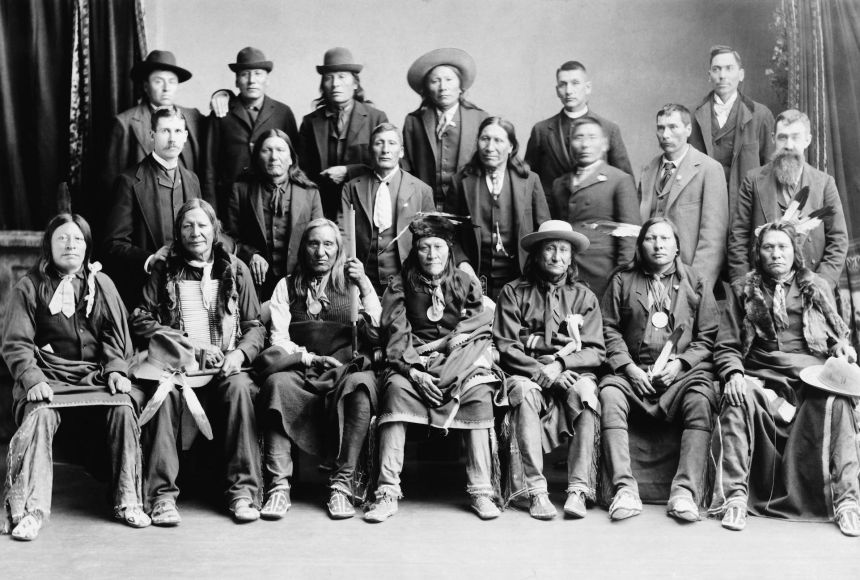The relationship between Native Americans and the United States government has long been tense. To many Native Americans, the history begins with their uneasy welcoming of the first European settlers. This period was followed by times of fighting, defeat, and near-extinction. To Americans, the history includes both treating Native American tribes as equals and exiling them from their homes. Often, these efforts happened at the same time.
Many Native Americans allied with the British during the Revolutionary War. However, the Treaty of Paris, which ended the war, was silent on the fate of these British allies. The new U.S. government was thus free to acquire Native American lands. Resistance from the tribes stopped the encroachment of settlers, at least for a while.
Boundaries of Tribal Lands
After the Revolutionary War, the United States made land treaties with Native American tribes. In general, these agreements defined the boundaries of tribal lands. They also stated how much the government would pay the tribes for taking their land.
Sometimes, the representatives of Native American tribes who signed the treaties were not authorized do so. For example, William McIntosh, chief of the Muscogee-Creek Nation, signed the Treaty of Indian Springs in 1825. The agreement gave away nearly all of the tribe's land in the state of Georgia. The Creek people said they had not authorized McIntosh to sign it, and later killed him.
Congress Has Power To Override Treaties
In 1903, the U.S. Supreme Court ruled that Congress had power over Native American affairs and could override treaties. Many treaties made before then, however, remain in force and occasionally, the Supreme Court is called upon to interpret them.
One treaty with ongoing consequences is the Treaty of Fort Laramie of 1868. The agreement was signed by the U.S. government and the Lakota Nation. In it, the United States pledged that the Great Sioux [Lakota] Reservation would be for the "undisturbed use" of the tribe. The land included the Black Hills, a small mountain range in western South Dakota that is sacred to the Lakota.
Neither side ever fully complied with the treaty, and when gold was discovered in the area, the United States tried to buy back the Black Hills. The Lakota rejected the offer, resulting in the Black Hills War (1876-1877). One of the war's most famous battles happened along the Little Bighorn River (June 25-26, 1876). General George A. Custer led a group of soldiers against the Lakota. Custer and his men were killed, and later the battle became known as Custer's Last Stand.
The Lakota's Constitutional Rights Violated
The United States continued its battle against the Lakota until reclaiming the Black Hills in 1877. In 1923, the Lakota sued, and 60 years later, the Supreme Court sided with them. It determined that the Lakota's constitutional rights had been violated. Under the Fifth Amendment, private land cannot be taken for public use without paying the landowner. The court ruled that the government owed the Lakota a reasonable price for the land plus interest. As of 2018, the amount due is around $1 billion. The tribe has refused to accept the money, however, because it is still seeking return of the land.
The Indian Removal Act of 1830 authorized President Andrew Jackson to remove and resettle Native Americans. The primary targets were tribes in the Southeast, such as the Cherokee and Creek. Although resettlement was supposed to be voluntary, ultimately, it was not. Thousands of Native Americans were forced from their homes and sent to "Indian Territory" west of the Mississippi River. The forced relocation became known as the Trail of Tears.
In 1887, the U.S. government passed the General Allotment Act. Under the law, the government was allowed to divide tribal land into small parcels for individual members. The goal was to pressure Native Americans into becoming farmers or ranchers. Lawmakers thought this would help tribal members assimilate, or become like other Americans. If land was left over, the government bought it back and sold it to white settlers.
Indian Reorganization Act of 1934
A new approach was undertaken with the Indian Reorganization Act of 1934. The law ended allotment and stopped the sale of Native American land. After World War II, however, some lawmakers favored ending tribes and closing reservations. A number were closed, including one belonging to the Menominee tribe in Wisconsin.
The civil rights movement in the 1960s influenced government policy with Native Americans. In 1975, the government passed the Indian Self-Determination Act. The law allowed tribes to self-govern and handle federal funds more independently.
In 1987, the Supreme Court ruled that states cannot regulate casinos on Native American land. This led to the Indian Gaming Regulatory Act of 1988. The law governs casinos operating on reservations.

